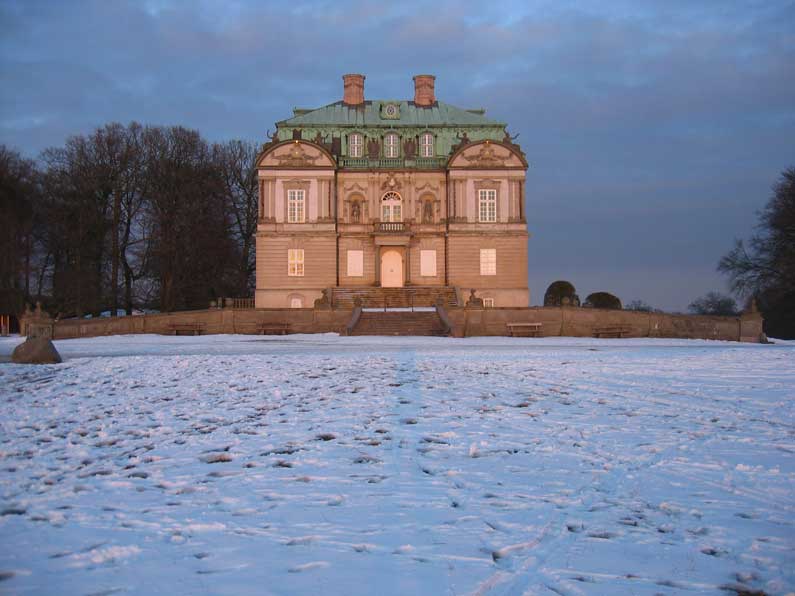- Eremitage Palace
Infobox Historic building

caption=The Eremitage Palace seen from west
name=Eremitage Palace
location_town=Dyrehaven
location_country=Denmark
architect=Lauritz de Thurah
client=Christian VI of Denmark
construction_start_date=1734
completion_date=1736
cost=18,000 rigsdaler
structural_system=
style=Baroque
size=The Eremitage Palace or Eremitage Hunting Lodge (Danish: _da. "Eremitageslottet" or _da. "Eremitagen") is located inDyrehaven north ofCopenhagen ,Denmark . The palace was built by architectLauritz de Thurah in Baroque style from 1734 to 1736 forChristian VI of Denmark in order to host royal banquets during royal hunts in Dyrehaven.Name
Never intended for residence, the Eremitage Palace was built as a setting for hosting royal banquets during hunts in Dyrehaven, which surrounds the palace. It originally featured a hoisting apparatus able to hoist the table from the basement to the dining room, allowing the King and his guests to dine without any waiters present, or "en ermitage" (in solitude), hence the name of the castle. [cite book |last=Sestoft|first=Jørgen|coauthors=Christiansen, Jørgen Hegner|title=Guide til dansk arkitektur 1 - år 1000-1960|origyear=1991|edition=2. edition|year=1995|publisher=Arkitektens Forlag|location=Copenhagen|language=Danish|isbn=87-7407-158-0|pages=p. 107] The apparatus was removed in the late 18th century as it was causing endless mechanical problems,cite web |url=http://www.ses.dk/398955f0 |title=The Eremitage Hunting Lodge|accessdate=2007-03-25|date=
2005-12-01 |publisher=Palaces and Properties Agency] and no signs of it remain.cite book|last=Christiansen|first=Torben|title=Dyrehaven|year=2005|publisher=Politikens Forlag|location=Copenhagen|language=Danish|isbn=87-567-7250-5|pages=p. 158] The previous castle on the site, the Hubertus chalet, had a similar apparatus and was nicknamed _da. "Heremitagen" for the same reason.cite book |last=Bauditz|first=Ove |authorlink= |coauthors= |editor= |others= |title=Jagtslottet Eremitagen i Jægersborg Dyrehave 1736-1936|series= |year=1936|publisher=Det Berlingske Bogtrykkeri|location=Copenhagen|language=Danish|pages=p. 10|chapter=Eremitagen 1736-1936]History
The area surrounding the palace was fenced as Jægersborg Dyrehave on the initiative of Frederick III, beginning in 1699. [Christiansen, p. 14.] The project was not completed in his lifetime, and Christian V, who was influenced by the time he had spent at the court of Louis XIV in France, changed the plans for the fencing to include a much larger area in order to facilitate a new style of driven hunt. This style of hunting involved having hounds run the prey tired and hold it down until a hunter would step off his horse and make the kill at little effort. In order for the hunters to be able to keep track of the hounds, a landscape with straight paths laid out to meet in star-shaped intersections, from which the hunters would be able to see the prey and the hounds whenever they crossed one of the paths, was required.
The fencing of the larger area resulted in a compulsory relocation of the residents, and among other things the village of Stokkerup was demolished, and today only the village pond remains, south of the palace.
The first palace on the site, the Hubertus chalet (Danish: _da. Hubertushuset), was built by
Hans van Steenwinckel III for Christian V, and was completed around 1694. It was a half-timbered house in two storeys, but the structure was most likely far too weak, [Christiansen, p. 154.] and in spite of extensive repairs in 1731, the chalet was in such a poor condition in 1734 that it was deemed necessary to tear it down and Lauritz de Thurah was hired to built a new palace on the site. [Bauditz, pp. 26-27.] The palace was built during 1734 to 1736 during the reign of Christian VI at a total cost of about 18,000 rigsdaler. [Bauditz, p. 30.]A planned renovation in 1786 was cancelled, as the estimated cost of 3,000 rigsdaler was considered too expensive.Bauditz, p. 49.] In 1790 the decision to tear the castle down was made, but the decision was not popular among everyone. Count Rantzau launched a defence of the palace and asked the king for permission to acquire it as his private property in exchange for Rantzau residence in
Jægersborg and for giving the king access to the palace. In 1794, the project succeeded, and Rantzau began a renovation of the palace at a cost of 4,000 rigsdaler. It did not take long for Rantzau to find the location of the palace inconvenient and remote, however. He decided to sell and by 1797 the palace was royal property again.In 1798, architect
Johan Boye Junge Magens initiated yet another round of repairs, and in the process many of the exterior sculptures and decorations were removed. Magens was, as fashion dictated, eager to rid the building of the decorations that made it typical of its time. [Christiansen, p. 159.]In the early 19th century, after the
Treaty of Kiel , Frederick VI changed the use of Dyrehaven; the area was mainly used for military exercises. The palace was still in use, but mainly for lunches for the king and officers. When Christian VIII became king in 1839, the hunts resumed. Additionally, the palace became the centre of large, public gatherings, and in this period it was often the site of political negotiations. On5 June 1854 it was the center of the first, large celebration of theConstitution of Denmark during which 30,000 people assembled in front of the palace.Christiansen, p. 161.]During the 1890s, architect
Ferdinand Meldahl supervised a thorough renovation taking great care to restore the original exterior decorations of the palace. The interior decorations, which had been painted over, were cleaned up and renovated with an almost religious attention to the original works.Today the castle is run by the Palaces and Properties Agency, a department of the Ministry of Finance and is made available to the royal family.
References
Wikimedia Foundation. 2010.
